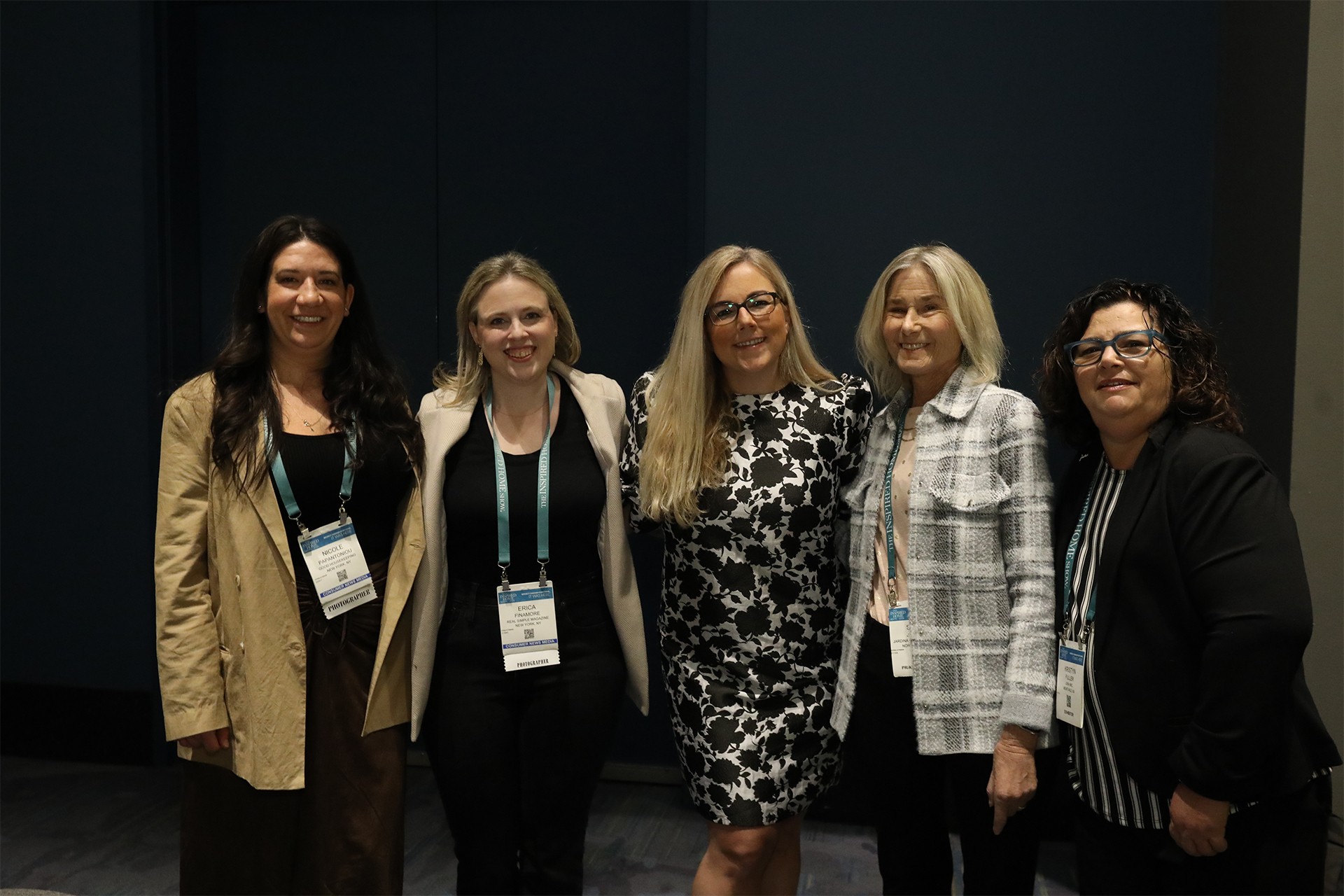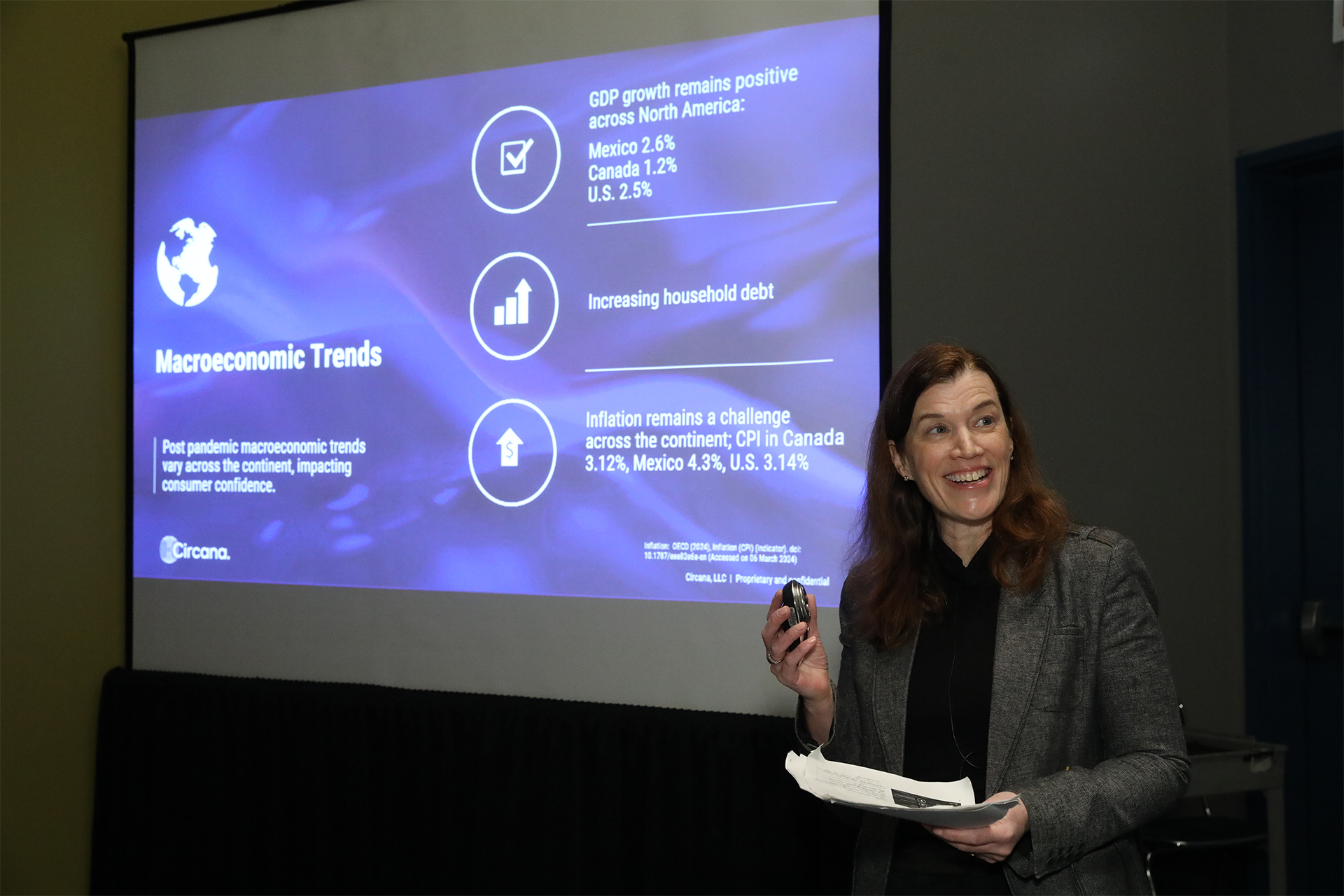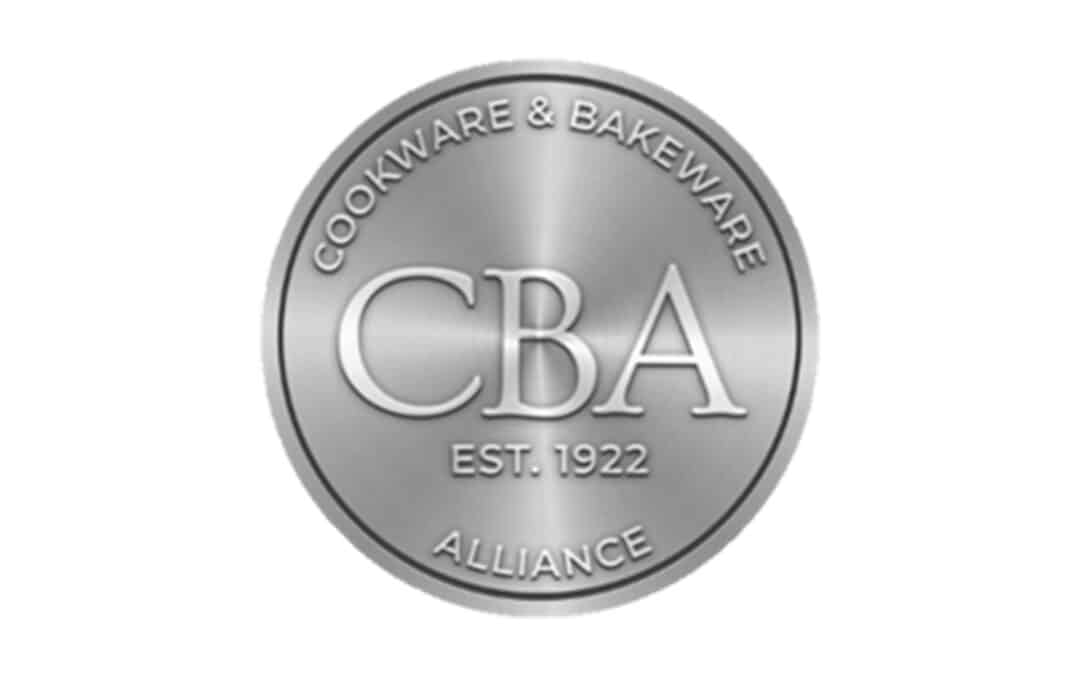On day three at the Inspiration Theater at The Inspired Home Show, presenters touched on a range of topics including opportunities in Canada and Mexico, how to think about media change and engagement, food trends that can drive housewares sales and ways to minimize the effects of replenishment system errors.
North American Housewares Market Trends – Identifying Opportunities for Growth in Canada and Mexico
Pam Wood, Circana
Renee Badiola, Circana
In the session, North American Housewares Market Trends – Identifying Opportunities for Growth in Canada and Mexico, Pam Wood (pictured above at the Inspiration Theater) and Renee Badiola of Circana looked at developments in North America to compare, contrast, and specify how trends are affecting the markets and housewares prospects ahead.
All three countries have been coping with post-pandemic recovery and macroeconomic trends that have resulted in distinctive market developments and consumer needs. Yet, Canada and Mexico have experienced those trends somewhat differently than the United States and have manifested them based on different needs and preferences at home.
Macroeconomic factors will continue to affect markets with inflation, positive but slowing GDP, rising debt and growing housing costs, with Canada affected by five-year mortgage renewals significantly boosting what homeowners are now paying monthly.
Some differences are telling, however. Only 22% of Mexicans purchase small kitchen appliances per year, versus 82% of consumers in the United States. As such, the potential growth opportunity upside is substantial.
“For Mexico, there is a lot of opportunity,” Badiola said. “We have many factors playing in our favor. Mexico can become the next opportunity for companies to grow.”
Indeed, when growth in small appliances, housewares and major appliances have slipped in Canada and the U.S. over the past year, they have grown in Mexico, up 14% in small appliances and 5% in Housewares.
Wood said not all is doom-and-gloom in Canada, however.
“There are growth opportunities,” Wood said. “There are growth opportunities with the right product and innovative products that meet consumer needs.”
Wood and Badiola outlined a series of segments where trends suggest opportunity. For example, in Canada, portable beverages, traditional food storage, certain cooking gadget segments, and tool sets have positive possibilities, with consumption patterns, especially food on the go, prompting change. In Mexico, cookware pans, cookware sets and pressure cookers look positive as consumers continue to invest in at-home food prep.
Coffee consumption is creating opportunities in both countries for related kitchen appliance segments, although differences exist. Both countries should see more demand for espresso makers, although traditional coffee blending is another potential gainer in Mexico. Appliances that provide single-serve blending also look positive. In Canada, ice cream/yogurt makers, rice cookers and kitchen systems could see growth, while the same is true for countertop microwaves and compact refrigerators in Mexico.
In Canada, personal care opportunities are likely to push hot air stylers, flat irons/straighteners, clothing irons, men’s electric shavers and facial trimmers, while in Mexico, irons and garment steamers have growth potential as consumers invest in their appearance, refresh clothing and travel. With more people getting out and about, travel-sized products are likely to get a boost.

L-R: Nicole Papantoniou, Erica Finemore, Emily Cappiello, Susan Jardina, Kristyn Fuller
How To Tell Your Company Story In Media’s Changing Landscape
Susan Jardina, Jardina Communications
Kristyn Fuller, Field Marketing + Media
Erica Finemore, Real Simple
Nicole Papantoniou, Good Housekeeping
Moderator: Emily Cappiello, Emily Jane Communications
In the seminar How To Tell Your Company Story In Media’s Changing Landscape, Susan Jardina, owner, Jardina Communications, Kristyn Fuller, managing director, Field Marketing + Media, Erica Finemore, home director, Real Simple, Nicole Papantoniou, director, kitchen appliance lab, Good Housekeeping, with moderator Emily Cappiello, principal of Emily Jane Communications, touched on change and opportunity in a rapidly evolved on a rapidly evolving industry.
Finemore noted that, at media companies, “things are changing really quickly. It used to be we had just print, now we’re trying to gather content for print, for digital, for TikTok, for Instagram, for our newsletter. So we need more content than ever, we’ve been creating more content than ever, and there are less people to do that than ever.”
Given the need, publications and the various satellite operations can be open to public relations materials. However, publications and their various ancillaries have to parse a heavy volume of information directed to them.
“I read all my emails. Constantly send emails,” Papantoniou said. “It’s really important to have personal relationships to really understand your messaging.”
The theme of personal relationships was a constant in the panel discussion. Papantoniou noted that knowing what kinds of content are needed at a particular publication is important and can be a basis for relationships.
From the public relations side, Jardina said that, in trying to get coverage, she recognized that fewer people are doing a lot of work in media operations.
“The most important thing now, really, is not necessarily trying to get into desk sides or meetings, but it’s really knowing what people are working on, what stories are coming up. That requires a lot of work on our part.”
Research is important, both to know what to pitch and when.
Cappiello noted that building relationships and interacting in a productive way means managing client expectations.
Along those same lines, Fuller said, “It’s the constant communication with the editor and also telling the client what we’ve been doing. I have always viewed PR as a momentum build business built over time.”
In outreach to publications, companies have to consider that fewer major outlets exist today, and those that remain in the market are more diverse and may require more diverse outreach as well as consideration of multiple schedules editors and writers face as they work on everything from web updates to major projects. So research and building personal relationships is a means of ensuring that the content sent is appropriate for the various needs publications have at any given time.
“We’re going to have less places to tell meaningful stories, so we have to really make those stories count,” Cappiello said.

Nick Stene, Euromonitor International
Restaurant Delivery, Grocery Shopping, and the Future of Home Cooking
Nick Stene, Euromonitor International
Catalina Flores, Euromonitor International
In the session, Restaurant Delivery, Grocery Shopping, and the Future of Home Cooking, Nick Stene, senior industry manager, and Catalina Flores, senior industry analyst, home and technology, U.S. specialist, at Euromonitor International, discussed how food trends could affect the housewares industry in the coming months. Inflation and other socio-economic factors have had an impact on food, for example, making eggs a more expensive protein and seafood even more expensive. Cost is making seafood less attractive to many consumers, but the still relatively reasonable price of eggs and consumer perception of them as a healthy edible, is maintaining demand.
Such shifts eventually affect housewares and other home products. For example, a number of factors are maintaining demand for air fryers, especially those with more features that are appropriate for a wider range of uses. Air frying vegetables can make them more attractive to kids, in one example, and the ability of air fryers to refresh leftovers, which are increasingly popular with consumers managing food budgets and time constraints, is supporting sales. Air fryer popularity, when combined with the increasing urbanization and housing costs forcing more people into less space, has potential consequences in what consumers want in their homes.
“What’s happening is people have gone from ‘Aren’t air fryers wonderful?’ to, ‘Do I really need an oven anymore?’”
Another change in the market is the growth of veganism, Stene said. Turmeric is popular in vegan foods, but it can quickly damage food packaging. As such, an opportunity exists to market food storage made with materials that can resist damage from turmeric to vegan households.
Flores pointed out that Euromonitor research demonstrates that foodservice has made gains with, consequently, less cooking in homes. However, the trend has its nuances.
“Something important is that maybe they’re not eating all their meals at the restaurants,” she said. “Consumers are searching for value. Maybe some are trading down to more affordable alternatives, but a lot are getting a lot of takeout and delivery and eating those meals at home.”
As consumers use foodservice more but eat at restaurants and related outlets less, they are looking for more food storage. However, what they are looking for is changing. A significant proportion of consumers have started to bring their own food and beverage containers to foodservice operators. The reasons may vary from hygiene to sustainability as they avoid throw-away packaging, but an opportunity exists. Indeed, some foodservice operations have been encouraging consumers to bring their own beverage containers for takeout. If the trend continues, beverage containers in formats that suit where they get their coffee and food containers that contract and expand so they take up less space in a backpack or briefcase could gain.
Larger trends suggest certain other possibilities, Stene and Flores pointed out. For example, plant-based milk requires different cleaning methods as it has a different composition than dairy. As such, it can be harder to clean, especially in dishwashers. Consumers have demonstrated more interest in learning to cook the meals they’ve eaten in restaurants at home and at the same quality, which suggests an opportunity for high-end cookware. Advances in appliances that contribute to healthy eating and products for hosting as consumers try to spend more time with friends are also consistent with trends Euromonitor has detected.
As noted, consumers are living in less space when they move into expensive urban environments, so ovenware that can convert into storage has become more attractive, as has stackable housewares and, gradually, cookware with detachable handles.

Doug Murless, Krunchbox
Retailer Replenishment Systems Don’t Work – Why You Need to Mine Your Retailers’ Point-of-Sale Data for Growth
Doug Murless, Krunchbox
Doug Murless, vice president, North America for Krunchbox, also billed as the Point of Sale Guy, in the session Retailer Replenishment Systems Don’t Work – Why You Need to Mine Your Retailers’ Point-of-Sale Data for Growth, pointed out that particulars in how information from stores is processed can mask out-of-stocks. Further, phantom inventory, misallocated stock, and dropped product/store combinations can cost a lot of money in lost sales. If the retailer doesn’t know that a store or a number of stores are out of a product, if their systems are reporting that inventory remains when it doesn’t or if they otherwise aren’t aware they need to replenish, the consequences can be dire.
“If you don’t address this, you’re never going to get another order,” he said.
Of course, as retailers set stock and replenishment terms, they set a maximum stock level and amount of inventory to be ordered in a given circumstance. When a store reaches a minimum stock level, the replenishment system generates an automated order. Retailers establish such systems to optimize inventory levels and ensure customers have products to purchase, but factors such as inaccurate forecasts and store and distribution center inventory data problems can cause failures.
To improve the situation, a company or analyst has to mine product and store data over a series of weeks to see where they have the same record of inventory on hand with zero sales. After that, an effective way to proceed, Murless said, is to prioritize what to fix and ask the retailer to zero out the inventory for the suspect product that may not be in store. Vendors can ask the retailer for a cycle count of the inventory of interest, and they can provide a phantom product list to the in-house merchandising team or a third party to check with stores and confirm inventory is missing. At that point, they can ask the retailer, store or department manager to mark the inventory as zero in their system if it isn’t there.
Companies can use available automation to reduce the manual effort otherwise involved and improve the speed and accuracy of replenishment orders. They can also request retailers to be more open and available in sharing results and provide data-based suggestions to help improve replenishments.





